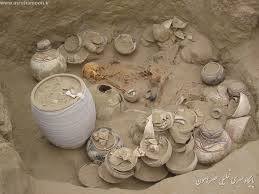Gold plated artificial eye, found together with the skeleton during excavations.
Shahr-e Sūkhté (Persian: شهر سوخته, meaning ” Burnt City”), also spelled as Shahr-e Sukhteh and Shahr-i Shōkhta, is an archaeological site of a sizable Bronze Age urban settlement, associated with the Jiroft culture. It is located in Sistan and Baluchistan Province, the southeastern part of Iran, on the bank of the Helmand River, near the Zahedan-Zabol road. In July 2014 it was placed on the World Heritage List of UNESCO.
The reasons for the unexpected rise and fall of the Burnt City are still wrapped in mystery. Artifacts recovered from the city demonstrate a peculiar incongruity with nearby civilizations of the time and it has been speculated that Shahr-e-Sookhteh might ultimately provide concrete evidence of a civilization east of prehistoric Persia that was independent of ancient Mesopotamia.
December 2006, archaeologists discovered the world’s earliest known artificial eyeball. It has a hemispherical form and a diameter of just over 2.5 cm (1 inch). It consists of very light material, probablybitumen paste. The surface of the artificial eye is covered with a thin layer of gold, engraved with a central circle (representing the iris) and gold lines patterned like sun rays. The female remains found with the artificial eye was 1.82 m tall (6 feet), much taller than ordinary women of her time. On both sides of the eye are drilled tiny holes, through which a golden thread could hold the eyeball in place. Since microscopic research has shown that the eye socket showed clear imprints of the golden thread, the eyeball must have been worn during her lifetime. The woman’s skeleton has been dated to between 2900 and 2800 BCE.
A recent discovery is a unique marble cup, which was found in 29, December 2014.
In January 2015, a Bronze Age piece of leather adorned with drawings was discovered
In December 2006, archaeologists discovered the world’s earliest known artificial eyeball. It has a hemispherical form and a diameter of just over 2.5 cm (1 inch). It consists of very light material, probably bitumen paste. The surface of the artificial eye is covered with a thin layer of gold, engraved with a central circle (representing the iris) and gold lines patterned like sun rays. The female remains found with the artificial eye was 1.82 m tall (6 feet), much taller than ordinary women of her time. On both sides of the eye are drilled tiny holes, through which a golden thread could hold the eyeball in place. Since microscopic research has shown that the eye socket showed clear imprints of the golden thread, the eyeball must have been worn during her lifetime. The woman’s skeleton has been dated to between 2900 and 2800 BCE.
The oldest known backgammon, dice and caraway seeds, together with numerous metallurgical finds (e.g. slag and crucible pieces), are among the finds which have been unearthed by archaeological excavations from this site.
Other objects found at the site include a human skull which indicates the practice of brain surgery and an earthen goblet depicting what archaeologists consider to be the first animation.
In January 2015, a Bronze Age piece of leather adorned with drawings was discovered
In December 2006, archaeologists discovered the world’s earliest known artificial eyeball. It has a hemispherical form and a diameter of just over 2.5 cm (1 inch). It consists of very light material, probably bitumen paste. The surface of the artificial eye is covered with a thin layer of gold, engraved with a central circle (representing the iris) and gold lines patterned like sun rays. The female remains found with the artificial eye was 1.82 m tall (6 feet), much taller than ordinary women of her time. On both sides of the eye are drilled tiny holes, through which a golden thread could hold the eyeball in place. Since microscopic research has shown that the eye socket showed clear imprints of the golden thread, the eyeball must have been worn during her lifetime. The woman’s skeleton has been dated to between 2900 and 2800 BCE.
The oldest known backgammon, dice and caraway seeds, together with numerous metallurgical finds (e.g. slag and crucible pieces), are among the finds which have been unearthed by archaeological excavations from this site.
Other objects found at the site include a human skull which indicates the practice of brain surgery and an earthen goblet depicting what archaeologists consider to be the first animation.
Animation of drawing on a pottery vessel found in Shahr-e Sookhteh, now in the National Museum of Iran.
















Комментариев нет:
Отправить комментарий